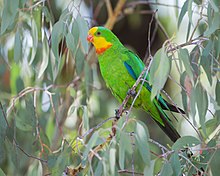Superb parrot
| Superb parrot | |
|---|---|
 |
|
| Adult male in Canberra, Australia | |
| Scientific classification | |
| Kingdom: | Animalia |
| Phylum: | Chordata |
| Class: | Aves |
| Order: | Psittaciformes |
| Superfamily: | Psittacoidea |
| Family: | Psittaculidae |
| Subfamily: | Psittaculinae |
| Tribe: | Polytelini |
| Genus: | Polytelis |
| Species: | P. swainsonii |
| Binomial name | |
|
Polytelis swainsonii (Desmarest, 1826) |
|
The superb parrot (Polytelis swainsonii), also known as Barraband's parrot, Barraband's parakeet, or green leek parrot, is a parrot native to south-eastern Australia. It is a dimorphic species and one of three species in the genus Polytelis.
The superb parrot is mostly bright green with darker flight feathers and is about 40 cm (16 in) long with a long pointed tail. Adult males have continuous yellow foreheads and throats, with a red horizontal band across the border of the throat.
First described by French naturalist Desmarest in 1826, the superb parrot, a dimorphic species, is one of three species in the genus Polytelis of long-tailed parrots. Common names include superb parrot and, in avicultural circles, Barraband's parrot or parakeet, named after the artist Jacques Barraband who illustrated it for Francois Le Vaillant in 1801 or green leek (although the last is applied to several unrelated species). Its closest relative is the regent parrot.
The superb parrot is medium-sized, bright green, approximately 40 cm (16 in) long, and has long tail feathers, a yellow-green neck, and yellow-orange irises. The adult male has a scarlet band on its upper chest and a bright yellow face and throat. The adult female has a pale blue-green face, greyish-green throat, a variable tinged russet-pink fore-throat, and orange thighs. Juveniles have brown irises and otherwise resemble females. The male has adult coloured plumage at the age of about one year.
An Australian endemic, the superb parrot is restricted to the dry (sclerophyll) woodlands of New South Wales and Victoria. There is estimated to be at least 10,000 individuals in the wild.
BirdLife International has identified the following sites as being important for superb parrot conservation:
It nests on hollow limb or a hole in a tree. During breeding season, small flocks of males often forage for food alone. Pairs may nest in a loose colonial system of as many as 6 pairs, so females are in the neighborhood at this time. The diet consists mainly of eucalypt flowers, fruits, nectar and pollen. It consumes seeds and green heads of the Yellow Box (Eucalyptus melliodora).
...
Wikipedia

